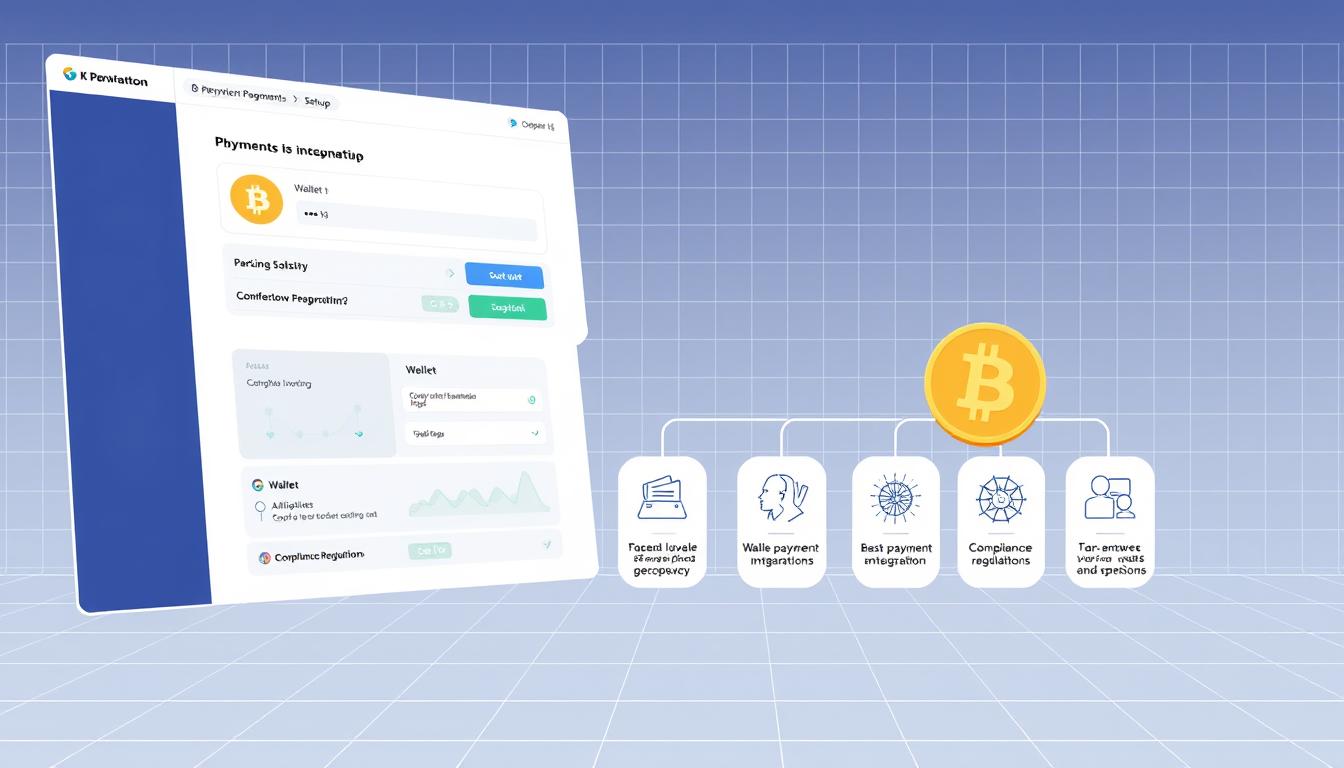Now Reading: Integrating Crypto Payments: The Essential Steps for U.S. Companies
- 01
Integrating Crypto Payments: The Essential Steps for U.S. Companies
Integrating Crypto Payments: The Essential Steps for U.S. Companies

Businesses in the U.S. can offer more payment options by learning how to add crypto payments. This guide covers the steps, from legal rules to technical setup. Check out CryptoMaximal’s payment gateway resources for secure solutions. They help ensure smooth operations and follow all laws.
Adding crypto payments can cut costs and reach more customers worldwide. But, it’s important to watch price changes and new laws. This guide shows how to balance new ideas with safety. It covers picking reliable processors and teaching staff about blockchain.
Key Takeaways
- Learn federal and state regulations impacting crypto transactions.
- Discover tools for selecting secure payment processors and infrastructure.
- Understand methods to manage price fluctuations and customer trust.
- Outline steps to train teams on compliance and technical systems.
- Track success using KPIs like transaction growth and customer adoption.
Understanding Cryptocurrency Payments in Today’s Business Landscape
Cryptocurrency payments are now a real part of business. In the last ten years, digital currencies like Bitcoin and Ethereum have grown. They are now seen as a real payment option.
Early tech and retail companies started using blockchain payment solutions. They liked how fast and clear these tools were. Now, U.S. businesses can use them to reach more customers and make transactions easier.
The Evolution of Digital Currency as a Payment Method
Bitcoin started in 2009, showing how digital transactions could work. By 2023, over 200,000 U.S. businesses accept digital currency in the United States. Big names like Shopify and Square now let customers pay with crypto.
Key Differences Between Traditional and Cryptocurrency Transactions
- Decentralization: No banks control crypto transactions.
- Lower fees: Sending money across borders is much cheaper than with credit cards.
- Speed: Payments are usually done in minutes, not days.
- Irreversibility: Payments can’t be taken back, which helps prevent fraud.
Current Adoption Rates Among U.S. Businesses
Recent studies show 15% of small-to-medium businesses now take crypto. Tech startups and online shops are leading the way. Blockchain solutions handle over $10 billion in U.S. business deals every year.
Companies that started early say they get more customers, especially the younger ones.
The Business Case for Accepting Digital Currencies
Adding crypto payments to American businesses opens new markets. Younger people, like millennials and Gen Z, prefer digital money. By offering crypto, businesses attract tech-savvy customers who see old ways as outdated.
This change can make customers more loyal and increase spending. People who value new things tend to spend more.
- Competitive Edge: Businesses that use crypto stand out in crowded markets.
- Cost Efficiency: Crypto transactions are cheaper than credit card fees. There’s no risk of chargebacks and settlements are faster.
- Global Reach: Making payments across borders is easier. This saves money on currency conversion for international clients.
Integrating crypto payments into a U.S. business needs careful planning. Companies can save money and reach more customers. For example, lower fees mean more money to invest.
Also, faster payments improve cash flow. Unlike old systems, which hold funds for days. Merchants who accept crypto avoid the 2-3% fees common in retail.
Challenges like price swings can be handled with tools or strategies. Platforms like BitPay and Coinbase Commerce make it easy to start. As more businesses join, ignoring crypto risks means missing out on revenue.
Legal and Regulatory Framework for Crypto Payments in the United States
Understanding the legal rules for cryptocurrency payment integration is key. U.S. businesses need to follow both federal and state laws. They also have to handle taxes correctly.

Federal Regulations Affecting Cryptocurrency Transactions
The SEC watches over crypto assets linked to securities. FinCEN makes sure businesses follow anti-money laundering (AML) rules. The CFTC handles crypto derivatives. First, figure out which agency’s rules you need to follow.
State-by-State Regulatory Differences
- Wyoming: It’s very friendly to crypto, with laws that help blockchain firms.
- New York: It has the BitLicense for virtual currency businesses.
- California: It focuses on protecting consumers and making sure businesses are clear about what they offer.
Tax Implications for Businesses Accepting Crypto
The IRS sees crypto as property. Businesses must track its value at the time of each transaction. They need to keep records of every deal’s date, amount, and USD value to figure out capital gains.
Compliance Requirements and Best Practices
Keep detailed records of all transactions. It’s a good idea to talk to legal experts to stay up to date with the rules. Regular checks and training on AML policies help keep you compliant. Working with licensed crypto service providers can also lower legal risks.
How to Integrate Crypto Payments into a U.S. Business: A Step-by-Step Approach
Starting with blockchain payment solutions needs a clear plan. Here’s how to add crypto payments smoothly:
Assessing Your Company’s Readiness
First, check your tech setup, staff skills, and what customers want. Use this guide to see if you’re ready:
- Make sure your IT can work with crypto APIs
- Look at how you handle payments now
- See if your team needs training
Selecting the Right Cryptocurrencies
Pick currencies that are stable and liked by customers. Think about:
- Bitcoin for its well-known status
- Ethereum for its smart contract features
- Stablecoins like USDC for steady value
Small businesses might choose popular ones. Tech companies could try new tokens.
Developing Your Implementation Timeline
- Phase 1: Research and planning (2-4 weeks)
- Phase 2: Choosing and setting up the platform (4-6 weeks)
- Phase 3: Training staff and testing (2 weeks)
- Phase 4: Launch and marketing
Most businesses take 3-6 months to fully integrate. Start small to avoid big risks.
Selecting the Right Crypto Payment Processor for Your Business
Choosing the right crypto payment processor is key for cryptocurrency payment integration. U.S. businesses need to look at providers like BitPay, Coinbase Commerce, and CoinPayments. They should check fees, supported coins, and how money is settled.
Start by looking at transaction costs. Some charge a fixed rate, while others use a percentage. Also, see which cryptocurrencies are supported. Common ones are Bitcoin, Ethereum, and stablecoins.
How fast money is settled is important too. Some services turn crypto to fiat right away. Others keep balances for later withdrawal.
- Fee Structures: Compare flat fees vs. percentage-based charges.
- Currency Support: Check which digital assets the processor handles.
- Security Features: Look for two-factor authentication and cold storage options.
- Integration Complexity: Prioritize APIs that align with your existing systems.
Small businesses might like Coinbase Commerce for its easy setup and low fees. It’s good for common coins. Big companies might need BitPay’s enterprise tier for advanced tools and scalability.
Make sure the provider’s settlement options fit your cash flow needs. Some hold crypto, while others convert it to USD right away. Always check if it works with your accounting software to avoid manual work.
Choose providers with clear fee information and 24/7 support. This way, integrating crypto payments for American businesses is smooth. It matches your business needs perfectly.
Technical Implementation: Setting Up Your Payment Infrastructure
Setting up blockchain payment solutions needs a solid plan. This part explains how to integrate crypto payments into a U.S. business. We look at technical steps like direct node integration or using third-party tools. Each choice has its own benefits and drawbacks.
Direct Integration vs. Third-Party Solutions
Companies can either manage their own nodes or work with services like BitPay or Coinbase Commerce. Running your own nodes gives you control but requires IT skills. On the other hand, third-party services are easier to use but cost money.
API Integration Considerations
API integration connects systems using RESTful interfaces. Developers should focus on:
- Encryption for transaction data
- Real-time validation checks
- API key management protocols
Tools like Stripe’s crypto add-ons or WooCommerce plugins make this easier.
Testing Your Payment System
Testing includes:
- Simulated transactions using testnet coins
- Penetration testing for security gaps
- Multi-platform compatibility checks
Platforms likeShopify have sandbox environments for safe testing.
Mobile and E-commerce Integration Specifics
E-commerce sites on Magento or Shopify can add crypto with plugins like Unocoin or CoinPayments. Mobile apps need SDKs from providers like Blockchain.com for secure in-app purchases.
Managing Price Volatility and Conversion Strategies
When accept digital currency in the United States, businesses must handle price changes. Cryptocurrency values change a lot, affecting earnings. This part talks about how to lessen risks while keeping the good points of cryptocurrency payment integration.
Auto-conversion vs. Holding Cryptocurrency
Businesses have to decide: convert crypto to USD right away or keep it. Tools like BitPay or Coinbase Commerce change it to USD fast, protecting against losses. But, keeping crypto can lead to gains, though it risks market changes. Most retailers choose auto-conversion for stability.
Setting Up Price Adjustment Mechanisms
Tools for changing prices in real time are available. They use APIs to update prices instantly. Platforms like CoinPayments make sure customers pay the right amount. This stops losses when crypto prices drop.
These systems change prices every few minutes to match the market.
Hedging Strategies for Risk Management
Big companies use futures contracts on places like CME Group to secure rates. Options trading lets them set price floors, protecting against drops. These methods need financial knowledge but cut down on market risks. Regular checks make sure hedging fits the company’s risk level.
Security Protocols for Protecting Crypto Transactions
Keeping crypto transactions safe is key for businesses using blockchain. Threats and the fact that transactions can’t be undone mean they need strong defenses. Companies using crypto payments must focus on keeping funds and customer data safe.
- Wallet Security: Store big amounts in cold storage and small amounts in hot wallets. Cold wallets are safer because they’re offline.
- Multi-Signature Authentication: Need more than one person to approve transactions. Using hardware security modules (HSMs) adds extra protection for big transfers.
- Access Control: Limit who can access crypto accounts with role-based permissions. Make sure all logins need two-factor authentication.
It’s important to check customers for fraud to stop scams. Regular security checks and training on phishing attacks help fight social engineering. Having a plan for when a breach happens is crucial. It includes steps to find breaches, isolate them, and follow reporting rules. Since crypto transactions can’t be undone, being proactive with security is essential.
Adding crypto payments to American businesses is a mix of new ideas and strong security. By using these measures, companies can follow rules and gain customer trust in a digital world full of risks.
Training Your Team to Handle Blockchain Payment Solutions
Getting your team ready for crypto payments is key. They need to know how to use blockchain solutions. Here’s how to train each team member.

Essential Knowledge for Customer-Facing Staff
Sales and customer service teams need to understand crypto basics. They should learn about:
- Cryptocurrency basics: wallet types, transaction confirmations, and common issues.
- How to process crypto payments step by step.
- Scripts to explain blockchain solutions to customers.
Technical Training for IT Personnel
IT teams need deep technical knowledge. They should learn about:
- Blockchain basics: nodes, ledgers, and smart contracts.
- How to install wallet software and integrate APIs.
- Best practices for keeping private keys and transactions safe.
Accounting Department Preparation
Accountants need to know about crypto taxes and accounting. They should learn about:
- IRS rules for crypto transactions under U.S. tax law.
- Tools for tracking crypto transactions and prices.
- How to automate reconciliations for blockchain payments.
Online courses like Coinbase Commerce Academy and Bitpay’s training are great. Regular workshops keep everyone up-to-date. Training helps avoid mistakes and boosts confidence.
Creating a Seamless Customer Experience with Crypto Payments
For businesses accepting digital currency in the United States, a smooth customer experience is key. Customers using crypto expect the same ease as traditional payments. Start by clearly listing crypto options on checkout pages.
Use integrating crypto payments for American businesses as a marketing highlight. This attracts tech-savvy buyers.
Simplify the process with QR codes for quick scans and pre-filled wallet links. Avoid jargon—explain terms like “blockchain confirmation” in simple language. Display real-time conversion rates to reduce confusion about value.
Include step-by-step guides for first-time users. Emphasize security and reliability.
- Offer 24/7 support channels for payment inquiries.
- Display average confirmation times next to crypto options.
- Provide email/text confirmations for completed crypto transactions.
Market crypto acceptance through social media and email campaigns. Highlight benefits like lower fees or faster international payments. Train staff to answer questions confidently.
Regularly update interfaces based on customer feedback to eliminate friction. A user-friendly crypto checkout builds trust and drives repeat business.
Real-World Success Stories: U.S. Companies Thriving with Cryptocurrency Payments
Businesses all over the U.S. are showing that using cryptocurrency can help them grow. From small startups to big companies, they’ve seen how accepting digital currency can increase their sales and reach more customers.
Small Business Case Studies
- Austin-based Coffee & Code started accepting crypto payments easily. In just six months, their sales went up by 30%. About 15% of their sales were in Bitcoin.
- Online store Urban Outfitters (not the clothing chain) cut down on credit card fees by 40% after working with a crypto processor. They saw a big jump in international orders, tripling.
Enterprise-Level Implementation Examples
Big names like Newegg started using crypto payments in 2022. Now, they handle over $5M in crypto each year. About 8% of their sales are in digital currencies. They managed the ups and downs of crypto prices with special tools.
Lessons Learned and Best Practices
Success often comes from clear pricing and dependable processors. For example, Overstock.com made sure their staff knew about crypto. This helped reduce customer confusion. Using platforms that update prices in real-time helped avoid price swings.
Overcoming Common Challenges When Implementing Digital Currency Payments
Businesses looking to add integrating crypto payments for American businesses face many obstacles. These include old systems, staff not wanting to change, or not knowing the rules. But, there are ways to overcome these challenges.

- Technical Barriers: Old systems might not work with new crypto tech. Working with APIs from companies like BitPay or Coinbase Commerce can help. Make sure to test everything to make sure it works well together.
- Operational Hurdles: If staff doesn’t know how to use it, it can slow things down. Offer training and clear guides to help them. Make sure customer service teams have answers and tools to help with questions.
- Financial Risks: The ups and downs of crypto can make pricing tricky. Use tools like CoinPayments to keep prices steady. QuickBooks Crypto Edition helps with tracking crypto for audits.
- Regulatory Concerns: Following IRS rules and state laws is very important. Use tools like Chainalysis Risk to watch transactions. Keep up with IRS and SEC updates to stay legal.
To integrate crypto payments into a U.S. business, start small. Begin with test runs and then grow. Get legal advice to make sure you’re following the rules. The Blockchain Association offers free webinars to help with regulations.
Measuring ROI and Performance of Your Crypto Payment System
Success in blockchain payment solutions needs clear metrics and tools. Businesses must look at how crypto payments affect revenue, customer behavior, and costs. Here’s how to evaluate your system:
Key Performance Indicators to Track
Focus on metrics that show real-world results. Key indicators include:
- Transaction volume and average spending per customer
- Reduction in processing fees compared to traditional methods
- Cart abandonment rates before and after crypto adoption
- Cryptocurrency-specific conversion rates for popular coins like Bitcoin or Ethereum
Analytics Tools and Reporting Methods
Platforms like Kubera’s crypto ROI analysis tools
Adjusting Your Strategy Based on Performance Data
Use insights to improve your strategy. Test different payment flows with A/B testing. If data shows, focus on top cryptocurrencies.
Adjust your marketing to reach crypto users. Regularly check if your blockchain payments meet your goals.
The Future of Business Payments: Staying Ahead in the Digital Currency Revolution
As the financial world changes, businesses need to get ready for new digital payment trends. Central Bank Digital Currencies (CBDCs), like a potential U.S. digital dollar, could change how companies accept digital currency in the United States. These new options might work alongside current cryptocurrencies, giving customers more ways to pay.
New tech like the Lightning Network and layer-2 solutions aim to fix old problems like high fees and slow transactions. Soon, adding crypto payments for American businesses could get easier, thanks to AI and IoT. Smart contracts could also make things smoother, leading to better customer experiences.
Getting clear rules is crucial. Businesses need to keep up with U.S. laws and adjust their plans. Companies that are ahead are testing new systems that mix crypto’s good points with old financial safety nets. This mix will be important as rules change and more people want these new payment methods.
To succeed, businesses should keep learning and updating their tech. Knowing about new trends helps them be ready for things like CBDCs. They also need to keep their practices safe and clear. The future of payments is fast-paced, and those who adapt first will be the leaders.
FAQ
What are the benefits of integrating cryptocurrency payments into my U.S. business?
Accepting digital currencies can attract new customers. It can also cut down on transaction fees and make cross-border payments easier. Plus, it can give you a competitive edge in a crowded market.
How do I assess my company’s readiness for cryptocurrency payment integration?
First, check if your tech can handle it. See if your customers want it and if your financial systems can adapt. Also, think about how much risk you’re willing to take. Use a checklist to see if you’re ready.
What are the key regulatory considerations for accepting crypto payments in the U.S.?
You need to follow rules from the SEC and IRS. This means knowing how to report crypto for taxes and following state laws on digital currencies.
Which cryptocurrencies should I consider accepting in my business?
Look at well-known ones like Bitcoin and Ethereum. Also, think about stablecoins like USDC and Tether. Choose based on your market and what you sell.
What should I look for in a cryptocurrency payment processor?
Check their fees, what currencies they support, and how secure they are. Make sure they work well with your current systems. Also, see how they support your business.
How can I manage the price volatility associated with cryptocurrency payments?
Use auto-conversion to USD to reduce risk. Or, set prices that don’t change much with market swings. If needed, use hedging strategies.
What security measures should I implement for cryptocurrency transactions?
Use strong wallets, cold storage for big amounts, and multi-signature and two-factor authentication. Training staff on security is also key to avoid fraud.
How can I effectively train my team to handle cryptocurrency payments?
Create training for different teams. Customer staff should know about transactions and how to fix issues. IT needs to learn about blockchain and security.
What are best practices for creating a seamless customer experience with crypto payments?
Clearly tell customers about payment options. Make checkout easy and user-friendly. Confirm transactions and offer good customer support for better satisfaction.
Can you share examples of U.S. companies successfully implementing crypto payments?
Yes, many have seen more customers and new income. Case studies can show you how to do it right.
What are common challenges when implementing cryptocurrency payment systems?
You might face tech issues, employee doubts, and rules to follow. Know these challenges early and plan how to overcome them.
How can I measure the ROI of my cryptocurrency payment system?
Track things like how many transactions you have, their value, and how many people use it. Use tools to see how you’re doing and improve.
What emerging trends should I be aware of in the cryptocurrency payment space?
Keep up with things like CBDCs, new payment tech, and changing rules. Staying current can help you stay ahead.

















